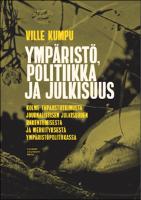Ympäristö, politiikka ja julkisuus
Kolme tapaustutkimusta journalistisen julkisuuden rakentumisesta ja merkityksestä ympäristöpolitiikassa
| dc.contributor.author | Kumpu, Ville | |
| dc.date.accessioned | 2020-02-10 09:49:53 | |
| dc.date.accessioned | 2020-04-01T08:52:34Z | |
| dc.date.available | 2020-04-01T08:52:34Z | |
| dc.date.issued | 2020 | |
| dc.identifier | 1007355 | |
| dc.identifier | OCN: 1290599755 | |
| dc.identifier.uri | http://library.oapen.org/handle/20.500.12657/22808 | |
| dc.description.abstract | "Drawing on the debate on mediatization of politics this study identifies cultural meanings, institutional practices and styles of argumentation as three theoretical dimensions that illuminate both the construction of journalistic publicity and its potential uses in political action. Based on the theoretical model, environmental politics is identified as a specific context for mediatization. In environmental politics, the interplay of cultural meanings, institutional practices and styles of argumentation define the construction and use of journalistic publicity in a way that differs from other fields of politics. The empirical part of this study analyzes the newspaper coverage of three Finnish environmental conflicts from 1971, 1994 and 2012. The theoretical model is transformed into an analytical framework that focuses on discursive construction of the conflicts (cultural meanings), journalistic frames, narration and opinion-giving in the coverage of the conflicts and the publicity practices adopted by actors during the conflicts (institutional practices) and legitimation of arguments (styles of argumentation). According to this study, the relation between media and politics in the field of environmental politics is defined by the increasing cultural significance of environmental protection from the 1970s to the present. In the newspaper coverage of the three environmental conflicts studied, changes on the frames, narration and opinion-giving of journalism resonated with this cultural change. However, the significance of environmental protection in the framing, narration and opinion-giving of journalism was greater in the national newspaper studied compared to the local newspapers selected based on their proximity to the conflict sites. Styles of argumentation appeared to be more case dependent. The increasing cultural significance of environmental protection did not have a clear effect on how arguments were legitimated. " | |
| dc.language | Finnish | |
| dc.subject.classification | thema EDItEUR::J Society and Social Sciences::JB Society and culture: general::JBC Cultural and media studies::JBCT Media studies | en_US |
| dc.subject.classification | thema EDItEUR::R Earth Sciences, Geography, Environment, Planning::RN The environment::RNP Pollution and threats to the environment | en_US |
| dc.subject.other | media coverage | |
| dc.subject.other | journalism | |
| dc.subject.other | publicity | |
| dc.subject.other | environmental politics | |
| dc.subject.other | mediatization | |
| dc.subject.other | environmental problems | |
| dc.subject.other | case study | |
| dc.subject.other | julkisuus | |
| dc.subject.other | ympäristöpolitiikka | |
| dc.subject.other | journalismi | |
| dc.subject.other | medioituminen | |
| dc.subject.other | ympäristöongelmat | |
| dc.subject.other | ympäristöjournalismi | |
| dc.subject.other | tapaustutkimus | |
| dc.title | Ympäristö, politiikka ja julkisuus | |
| dc.title.alternative | Kolme tapaustutkimusta journalistisen julkisuuden rakentumisesta ja merkityksestä ympäristöpolitiikassa | |
| dc.type | book | |
| oapen.relation.isPublishedBy | a58c317d-aa1d-4cda-913b-073587647c91 | |
| oapen.pages | 180 | |
| oapen.place.publication | Tampere | |
| oapen.notes | 2020-02-10 09:37:45, Funder: Academy of Finland | |
| oapen.remark.public | 21-7-2020 - No DOI registered in CrossRef for ISBN 9789523590120 |

